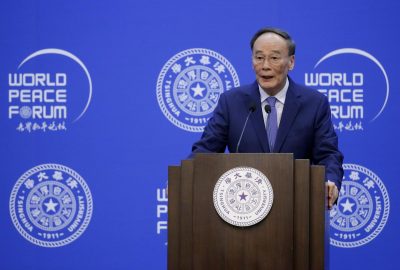China’s Belt and Road, Trump’s Trade War and the Future of the Global Economy

Chinese Vice President Wang Qishan told the audience at this year’s World Peace Forum that “development is the key to resolving all issues”, remarking in the run-up to his conclusion that “China’s development can’t shut out the rest of the world” and “the world’s development can’t shut out China”. International media interpreted his remarks as a jab against Trump’s protectionist economic policies and the aggressive trade war that he’s waging in an effort to reroute the global supply chain away from China, but his words are much more important than the reactive rhetoric that they’re being presented as.
In fact, Vice President Wang’s comments are visionary because they represent a completely new model for resolving the world’s many conflicts, one which could realistically be applied through China’s Belt & Road Initiative (BRI). To explain, the previous approach to resolving international problems has been the use of force or the threat thereof, something that the US has over-relied on since World War II and especially since the end of the Cold War. Washington has also started waging hybrid wars against targeted states whereby it uses informational and economic means to undermine targeted states in order to extract concessions from them.
The American approach has destabilized the world, made it a more dangerous place, and negatively impacted the developmental prospects of the millions of people victimized by this policy, but China has now created a model for counteracting all of those consequences and repairing the damage the the US is responsible for. The end goal of BRI is to build a community of shared destiny in which all countries have an equal stake in maintaining the emerging multipolar world order that’s being pioneered by the new trade routes that China is constructing, which can imbue their people with a sense of optimism for themselves and future generations.
This is immensely important because certain at-risk demographics such as some ethnic and religious minorities are less likely to be influenced by extremist ideologies if they truly believe that they have a chance to succeed in the existing system, therefore reducing the likelihood of them committing terrorist acts in an effort to radically change the status quo that they’re so dissatisfied with. Of course, there will always be some irredeemable radicals who aren’t positively influenced by the visible development taking place all around them, but the majority of dissatisfied and at-risk individuals aren’t blind to the many opportunities that this entails for them.
As a case in point, the China-Pakistan Economic Corridor (CPEC) has brought so many benefits to the host state’s previously underdeveloped region of Balochistan that the founder of the “Baloch Liberation Front” Dr. Jumma Khan Marri disowned the separatist cause that he previously fought for and launched the Overseas Pakistani Baloch Unity (OPBU, nowadays rebranded simply to PBU) organization last year for peacefully reintegrating his wayward compatriots back into the national fold. He even went on record as crediting CPEC for inspiring him to lay down arms because he said that it has given the Baloch hope for their future.
The precedent trailblazed by Dr. Jumma could prospectively be applied in Myanmar’s Rakhine State through the China-Myanmar Economic Corridor (CMEC) if the government worked together with the region’s Rohingya minority to replicate the success that the Baloch have achieved in Pakistan through CPEC, which could in turn inspire local militants to also abandon their armed campaign against the state as long the developmental needs that they were fighting for are properly met. The same can be said for the many militant groups in India’s Northeast if New Delhi made progress on the Bangladesh-China-India-Myanmar (BCIM) Economic Corridor.
BRI’s economic integration of peripheral minority groups into the national fabric can facilitate their assimilation into society and consequently increase the odds that political solutions can be found to their armed conflicts. That’s what Vice President Wang was implying when he said that “development is the key to resolving all issues” and why he pointed out the impossibility of isolating China’s development from the rest of the world’s. The socio-political benefits derived from BRI’s worldwide network of Silk Road economic connectivity are a key component of the new international system and are thus indispensable for ensuring global stability.
*
Note to readers: please click the share buttons above or below. Forward this article to your email lists. Crosspost on your blog site, internet forums. etc.
This article was originally published on Oriental Review.
Andrew Korybko is an American Moscow-based political analyst specializing in the relationship between the US strategy in Afro-Eurasia, China’s One Belt One Road global vision of New Silk Road connectivity, and Hybrid Warfare. He is a frequent contributor to Global Research.
Featured image: Chinese Vice President Wang Qishan delivers a speech at the opening of World Peace Forum at Tsinghua University, in Beijing, China, July 8, 2019 (Source: OR)

